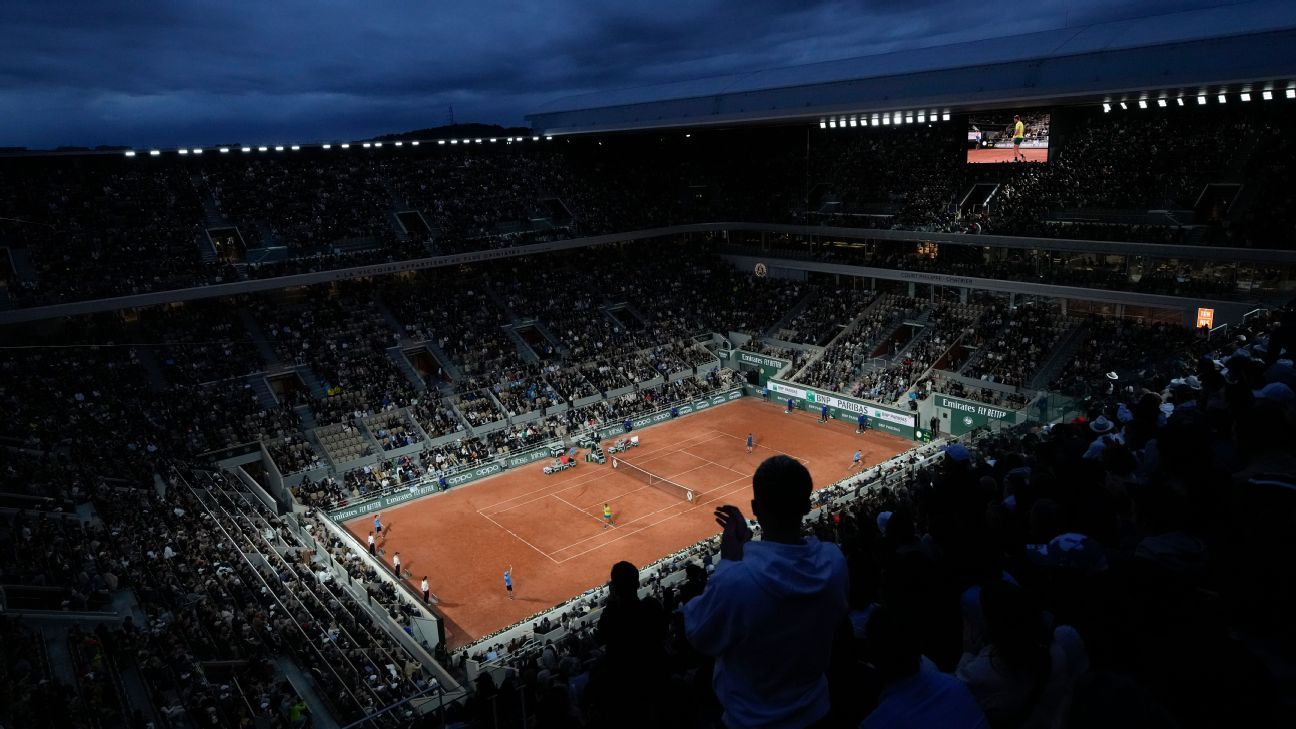Products You May Like
PARIS — When Roland-Garros organizers added night sessions to the schedule for the first time last year, they had matches such as Tuesday’s slate in mind, as Novak Djokovic and Rafael Nadal go head-to-head for a place in the semifinals.
It’s a repeat of last year’s semifinal, which had an electric atmosphere despite only 5,000 fans being allowed in due to COVID-19 restrictions. On Tuesday, there will be a capacity crowd of almost 15,000 and a huge TV audience worldwide.
Preceded by a special DJ session to get the crowd warmed up, the evening sessions have a noticeably different vibe from the day matches. But the fans still seem happy, and Amazon TV — which paid for exclusive rights to show the night sessions in France in a three-year deal — seems happy.
But a lot of players don’t like them, especially Nadal, whose heavy topspin does not work as well when conditions are humid and the temperature is cooler.
“I don’t like night sessions on clay,” Nadal said after his fourth-round win. “I say the other day. I am very clear with that. I don’t like to play on clay during the night, because humidity is higher, the ball is slower, and can be very heavy conditions especially when it’s cold.
“I think that makes a big difference on the way tennis is played on clay during the night and during the day.”
Alexander Zverev, the No. 3 seed who faces Carlos Alcaraz in the quarters Tuesday, agrees.
Nadal/Djokovic LIX pic.twitter.com/gvEWUTvmEr
— US Open Tennis (@usopen) May 29, 2022
“I don’t mind the evening sessions when it’s 30 degrees [Celsius, 86 Fahrenheit] during the day, you know,” he said after his fourth-round win. “When it’s 14 degrees, like today, then in the night it’s going to be what, 8, 9, something like that, it gets difficult.
“Because my serve is going to be even slower, my forehand is going to be even slower. It’s not going to be an easy thing for me to play at 9:30 at night with no sunlight, with no heat, and 8 degrees.”
Former world No. 2 Alex Corretja told Eurosport last year that the clay changes significantly between day and night.
“It can create problems for players a little bit if matches go long into the night because matches will finish late, conditions will be totally different,” he said.
“It is the same in different Slams we know, but here especially the clay will be so wet.”
It’s not just the conditions.
Night sessions at Roland-Garros start at 8:45 p.m. in Paris, beginning with music from DJ Set and Match before the contests themselves get underway at 9 p.m.
Nadal and Djokovic have played out numerous epic battles over the years, including last year’s semifinal, which took 4 hour hours, 11 minutes.
If Tuesday’s quarterfinal lasts a similar length of time, it would finish after 1 a.m., something that would present the tournament with a number of issues.
With a finish that late, once players are done with their media commitments and their recovery programs, they probably don’t get to bed until around 4 a.m.
Zverev blamed late-night sessions for his easy defeat by Alcaraz when they played in the Madrid Masters final earlier this month, having played back-to-back matches the previous two nights that finished in the early hours.
“I have to say the ATP’s job was an absolute disgrace this week,” he said in Madrid. “Two days ago I went to bed at 4 a.m., 4:30 a.m. Yesterday I went to bed at 5:20 a.m.”
Two words:
Nadal.
Djokovic.
— US Open Tennis (@usopen) May 29, 2022
While Grand Slams have the advantage of offering players a day off between matches, that day off becomes more of a balancing act if you’re going to bed just as the sun is coming up.
New Roland-Garros tournament director Amelie Mauresmo said a lot goes into deciding the schedule and who plays at night.
“We wanted to expand our efforts this year to make it more comfortable for the players,” Mauresmo told ESPN. “Spaces have been set up so that they can concentrate and stay in their own bubble in order to arrive ready for their match. The players have the possibility to sleep. And the time of the end of their match is taken into account when scheduling their next match.”
There will be 10 night sessions in all. Of the nine scheduled so far, including Tuesday’s Nadal-Djokovic clash, only one has been a women’s match: Alize Cornet against Jelena Ostapenko.
The disparity has been another source of contention. The ticket price does not change whether it’s men or women in the night session, but Mauresmo admits they have favored the men in scheduling.
“Attention is paid to the most beautiful matches, whether male or female,” she said. “There are no particular rules. But it is true that more men’s matches are scheduled because it offers a longer show time.”
Djokovic, though, seems happy enough to play at night.
“You just have to adjust to that,” he said after his fourth-round win.
“Obviously, depending on who you play, sometimes it’s favorable to play night; sometimes day. Yeah, there is no standard or no formula that works always, so to say. Even though I historically played very well and won a lot of matches under the lights on different slams, particularly in Australia.”
Night sessions are here to stay, it seems.
“The schedule makes it possible to manage the flow and to offer a musical show for a real spectator experience,” Mauresmo said. “We will assess the situation at the end of this edition to see if any adjustments are necessary. “
